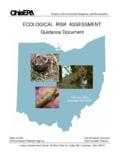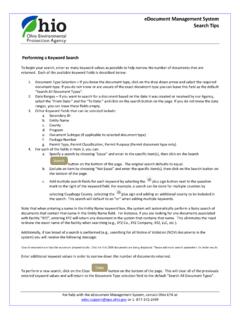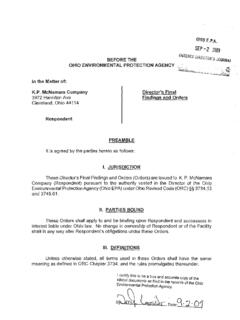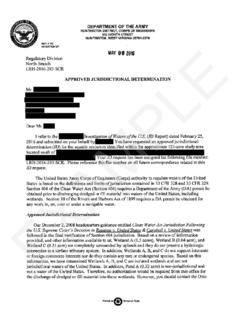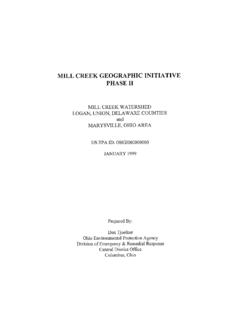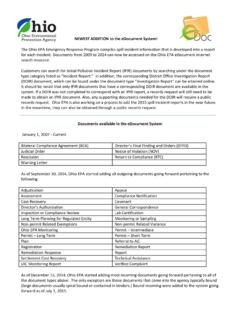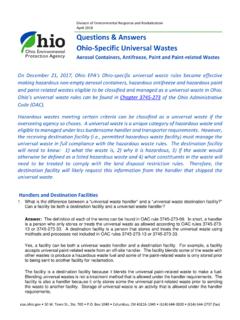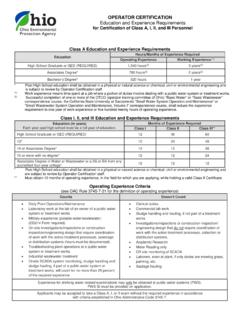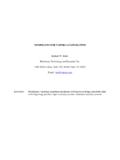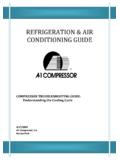Transcription of Division of Air Pollution Control May 9, 2017 (First ...
1 50 W. Town St., Ste. 700 Box 1049 Columbus, OH 43216-1049 (614) 644-3020 (614) 644-2737 (fax) Division of Air Pollution Control May 9, 2017 (First Issuance) Engineering Guide #74: Condensable and non-condensable particulate matter Question: How does Ohio EPA, DAPC address condensable and non-condensable particulate matter when specifying permit emission limitations; conducting compliance demonstrations; and reporting emission fees? Background: In 1987, USEPA established new National Ambient Air Quality Standards (NAAQS) for PM10 which replaced the NAAQS for PM.
2 In 1997, USEPA replaced the existing PM10 standard with a health based standard and retained the PM10 standard as a coarse standard protecting welfare. In 2006, EPA revised the 24-hour standard from 65 micrograms of particles per cubic meter ( g/m3) of air to 35 g/m3. In 2012, EPA revised the primary annual standard from g/m3 to g/m3, retained the existing 24-hour standard at 35 g/m3, retained the existing 24-hour PM10 standard at 150 g/m3, and retained the current suite of secondary PM standards. In 2005, EPA promulgated the initial nonattainment areas for the standards across the country, and in 2015, promulgated the nonattainment areas for the 2012 annual NAAQS.
3 Much of what constitutes is not directly emitted to the atmosphere, but is formed in the atmosphere by a chemical reaction between sulfur dioxide, oxides of nitrogen and organic and elemental carbon. Consequently, in order to reduce concentrations, regulators need to bring about reductions of SO2, NOx, and primary particulates until it can be demonstrated that the standards will be met. In developing the State s revised Implementation Plan to meet the standards, predictive modeling is performed, in part, to determine if the standards will be met.
4 The modeling data considers the impact of primary emissions (the combination of filterable and condensable particulate matter). While compliance with the applicable and PM10 NAAQS may consider the impact of primary and PM10 emissions, most of the USEPA s NSPS and NESHAPS only regulate filterable particulate matter. This is also true for many of DAPC s historic BAT determinations under OAC rule 3745-31-05. Since 2011, DAPC has only established primary and/or PM10 emission limitations for significant PSD or nonattainment NSR PM10 or sources and significant synthetic minor sources that are avoiding major NSR.
5 The following guidance attempts to clarify how DAPC will address the various forms of particulate matter when specifying permit emission limitations; conducting compliance demonstrations; and reporting emission fees. Answer: Please see the definitions included in Attachment A of this guidance. Permitting/Compliance Demonstrations: With respect to permit emission limitations and corresponding compliance demonstrations, Ohio EPA, DAPC addresses condensable and non-condensable particulate matter based upon the regulations applicable to the affected emissions unit.
6 Through OAC Chapter 3745-17, DAPC regulates particulate emissions, visible particulate emissions, and emissions of fugitive dust. Particulate emissions are a subset of particulate matter emissions. As collected and measured, particulate emissions would be classified as non-condensable particulate matter. Particulate emissions are the filterable particulates (from heated sampling probe and filter) collected and measured by the procedures in USEPA Method 5. Please note that the filterable particulate also includes any material that condenses at or above the filtration temperature.
7 The particulate matter standards in OAC Chapter 3745-17 were developed, in part, based upon emission tests conducted in accordance with USEPA Method 5 and/or Method 17 (40 CFR Part 60, Appendix A). As such, any demonstration of compliance with the OAC Chapter 3745-17 particulate emission limitations is conducted using USEPA Method 5 (or approved alternative method , USEPA Method 17) where only the filterable particulate from the sampling train s probe and filter is collected and measured. Engineering Guide #74 P a g e |2 In a similar manner, OAC Chapter 3745-17 only regulates a subset of visible emissions - visible particulate emissions.
8 USEPA Method 9 is one of the approved methods that can be used to determine compliance with the OAC Chapter 3745-17 visible particulate emission limitations. While USEPA Method 9 can be used to determine the opacity of any visible emissions, it would not be appropriate to use the observed opacity of condensing organic emissions to assess compliance with a standard established solely for visible particulate emissions. PM10 and definitions are referenced in OAC Chapter 3745-17; however, these definitions were related to the requirements for ambient air monitoring of particulates under OAC rule 3745-17-02 which was rescinded.
9 Ambient monitoring for the appropriate forms of particulate matter is now addressed in OAC Chapter 3745-25. Through OAC Chapter 3745-31, DAPC currently regulates particulate emissions, visible particulate emissions, emissions of fugitive dust, filterable particulate matter, primary particulate matter, primary PM10, and primary Primary particulate matter emissions (the combination of filterable particulate matter and condensable particulate matter, as collected and measured by the appropriate USEPA Methods) represents the total particulate matter emissions released from a source to the atmosphere.
10 Primary PM10 emissions (the combination of filterable PM10 and condensable particulate matter); and primary emissions (the combination of filterable and condensable particulate matter) are subsets of particulate matter emissions. Some of the older BAT determinations still regulate particulate emissions, visible particulate emissions, and emissions of fugitive dust based upon the timeframe the permits containing the BAT determinations were issued. The emission limitations/ Control measures tables cited BAT determinations under OAC rule 3745-31-05 and those determinations included the statement that BAT also included compliance with OAC rules 3745-17-07, 3745-17-11, etc.
